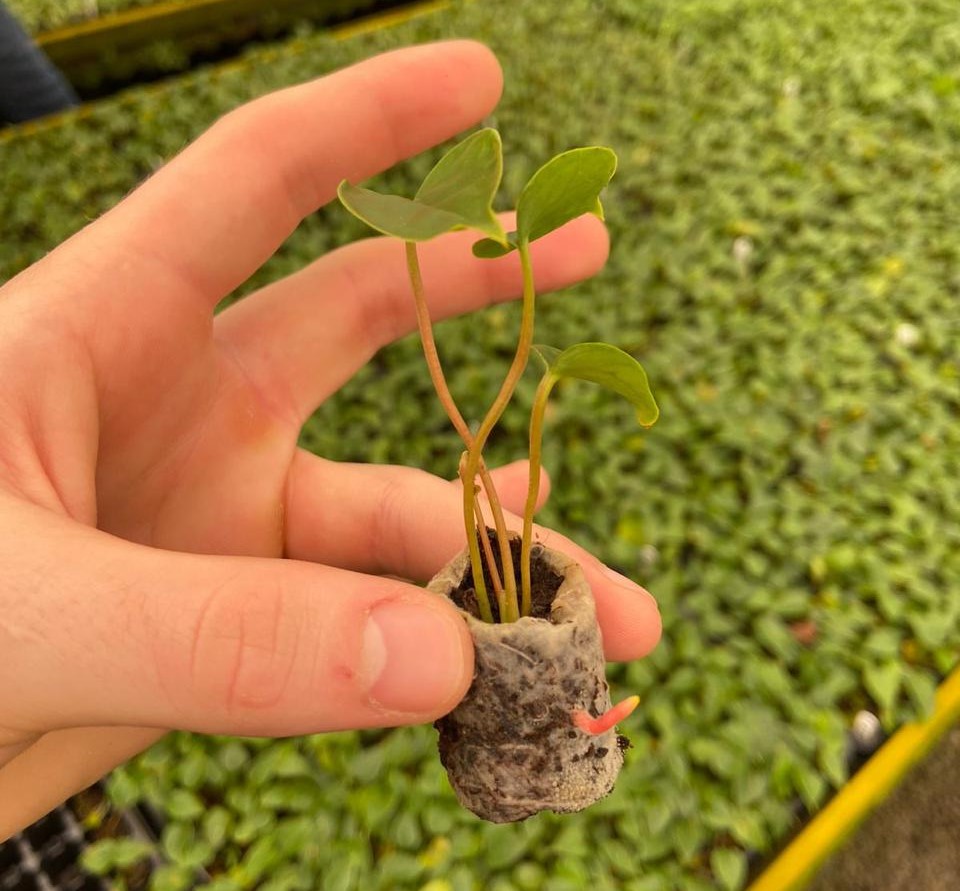


The biodegradable film was used to mold pots that are 4 cm high and 3.5 cm in diameter (photo: André Felipe Silverio Neubern)
Published on 07/22/2025
By Karina Ninni | Agência FAPESP – Researchers from the Federal University of São Carlos (UFSCar) in the state of São Paulo, Brazil, have developed a film based on algae and nanocellulose in partnership with an anthurium grower from Holambra, also in the state of São Paulo. This film is an improvement over the imported material the grower previously used to reproduce the plant. The film is capable of slowly releasing fertilizer into the substrate, which gives it an advantage over the imported material. With adaptations, it can be used to propagate various crops, including ornamental anthuriums.
“In the case of the anthurium, our partner uses a container manufactured by a foreign company to reproduce the plant tissue in the laboratory. This company produces paper and a machine. Other entrepreneurs buy the paper and machine and supply these pots, which, according to him, are very expensive,” Claudinei Fonseca Souza, from the Water, Soil, and Environmental Engineering Research Group at UFSCar’s Araras campus, explained to Agência FAPESP.
Seeking an advantage over the imported product, the UFSCar team developed the idea of using carrageenan (extracted from red algae) and alginate (obtained from brown seaweed) to store MAP (monoammonium phosphate, NH₄H₂PO₄), a widely used fertilizer for various crops.
“The challenge in using polymers like carrageenan and alginate is obtaining resistant materials since they tend to dissolve quickly when in contact with water. That’s why we added cellulose nanofibers to the material in different concentrations, hoping to improve its mechanical, physical, chemical, and thermal properties,” says the researcher.
Thus, the team produced a film with which they molded pots that are 4 centimeters high and 3.5 cm in diameter. These pots can replace those traditionally used to propagate the plant.
“This film has to maintain the structure of the plant, but it can’t resist the root system. In other words, it has to be resistant, but not too resistant. That’s why we tested adding 1% to 5% nanocellulose to the material. We obtained the best result with 4%. Our intention now is to patent the material and start testing it on other crops,” says Souza.
He points out that the root is important to the plant in two ways: first, as support, and second, for absorbing water and nutrients. “When designing the material, we can’t forget either of them. From this film with 4% nanocellulose, we moved on to the field test, which hasn’t yet been published. We used a technique that can give an idea of the material released from the electrical conductivity of the soil. We also did a degradation test. Every 30 days we went to Holambra, collected the plants, and made an assessment. And we observed that the material disappeared after 90 days.”
According to Souza, the nutrients are released due to the difference in potential between the fertilizer-enriched material and the plant substrate, which lacks the substance.
“We’re testing in real conditions, in the field, doing the same as the farmer. With the support, therefore, of agronomy. There are techniques for monitoring the release of the material almost in real time.”
The work, published in the journal Cellulose, was supported by FAPESP through a Regular Research Grant awarded to Professor Roselena Faez, the article’s second author.
Advantages
In the laboratory, the scientists used a 3D printer to make 10x20 centimeter sheets of the material from filaments of ABS (a thermoplastic resin derived from petroleum and obtained from the combination of three monomers: acrylonitrile, butadiene, and styrene). They then wrapped the film around a round steel template and glued it together to form the vases.
“We were able to make grooves in these sheets that make it easier for the roots to come out. And the root itself, as it grows, reinforces the material,” says Souza.
He believes that producing the film on a large scale is perfectly possible, given Brazil’s easy access to algae and its status as the world’s largest producer of cellulose. “But to get to scale, we need to develop this final part, analyze the results of the field work, and patent the material. We’re looking for raw materials that are abundant and at a good price, because there’s no point in developing an excellent film that’s very expensive and doesn’t reach the farmer.”
Souza points out that the film made from algae and nanocellulose has several advantages. It saves fertilizer because there is less loss through leaching – the algae hold the compounds, so they aren’t washed away by rain or irrigation – and it eliminates the need for plastic because the film can replace the microplastic spheres used in large-scale agriculture to release fertilizers. “We use the same technique of inserting fertilizer into the plastic spheres, except that our material is biodegradable. After 90 days, it practically disappears.”
The article “Enhancing marine algae composites with cellulose nanofibrils for sustainable nutrient management” is available at link.springer.com/article/10.1007/s10570-024-05947-0.
Source: https://agencia.fapesp.br/55389